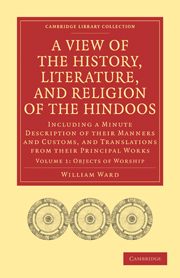 A View of the History, Literature, and Religion of the Hindoos
A View of the History, Literature, and Religion of the Hindoos Book contents
- Frontmatter
- Contents
- INTRODUCTORY REMARKS
- CHAP. I OF GOD
- CHAP. II OF THE GODS
- CHAP. III OF THE GODDESSES
- CHAP. IV INFERIOR CELESTIAL BEINGS OBJECTS OF WORSHIP
- CHAP. V OF THE TERRESTRIAL GODS
- CHAP. VI TERRESTRIAL GODDESSES
- CHAP. VII DEITIES WORSHIPPED BY THE LOWER ORDERS ONLY
- CHAP. VIII WORSHIP OF BEINGS IN STRANGE SHAPES
- CHAP. IX WORSHIP OF HUMAN BEINGS
- CHAP. X WORSHIP OF BEASTS
- CHAP. XI THE WORSHIP OF BIRDS
- CHAP. XII THE WORSHIP OF TREES
- CHAP. XIII THE WORSHIP OF RIVERS
- CHAP. XIV THE WORSHIP OF FISH
- CHAP. XV THE WORSHIP OF BOOKS
- CHAP. XVI THE WORSHIP OF STONES
- CHAP. XVII A LOG OF WOOD WORSHIPPED
CHAP. IV - INFERIOR CELESTIAL BEINGS OBJECTS OF WORSHIP
Published online by Cambridge University Press: 05 October 2010
- Frontmatter
- Contents
- INTRODUCTORY REMARKS
- CHAP. I OF GOD
- CHAP. II OF THE GODS
- CHAP. III OF THE GODDESSES
- CHAP. IV INFERIOR CELESTIAL BEINGS OBJECTS OF WORSHIP
- CHAP. V OF THE TERRESTRIAL GODS
- CHAP. VI TERRESTRIAL GODDESSES
- CHAP. VII DEITIES WORSHIPPED BY THE LOWER ORDERS ONLY
- CHAP. VIII WORSHIP OF BEINGS IN STRANGE SHAPES
- CHAP. IX WORSHIP OF HUMAN BEINGS
- CHAP. X WORSHIP OF BEASTS
- CHAP. XI THE WORSHIP OF BIRDS
- CHAP. XII THE WORSHIP OF TREES
- CHAP. XIII THE WORSHIP OF RIVERS
- CHAP. XIV THE WORSHIP OF FISH
- CHAP. XV THE WORSHIP OF BOOKS
- CHAP. XVI THE WORSHIP OF STONES
- CHAP. XVII A LOG OF WOOD WORSHIPPED
Summary
These beings are either the enemies of the gods, as the ŭsoorŭs and rakshŭsŭs; or their companions; or those who are employed as dancers, singers, or musicians in the heavens of the gods. They are worshipped at the great festivals, but have no separate images.
SECT. I.—The Usoorŭs, or Giants
These enemies of the gods are the offspring of Kŭshyŭpŭ the progenitor of gods, giants, men, serpents, and birds, by his different wives. They bear a resemblance to the titans or giants of the Grecian Mythology; and stories of their wars with the gods (some of which will be found in this work) abound in the pooranŭs. Indrŭ, Vishnoo, Kartikŭ, and Doorga, are distinguished among the Hindoo deities for their conflicts with these beings. King Vŭlee, a giant, is worshipped by the Hindoos on their birth-days, with the same forms as are used in the worship of the gods.
Story of the churning of the sea by the gods and ŭsoorŭs.—
The most rancorous hatred has always existed betwixt the ŭsoorŭs and the gods, although half-brothers; the former having been excluded by the gods from succeeding to the throne of heaven: and dreadful conflicts were carried on betwixt them with various success, till both parties sought to become immortal. The giants performed the most severe religious austerities, addressing their prayers alternately to Vishnoo, Shivŭ, and Brŭmha; but were always unsuccessful.
- Type
- Chapter
- Information
- A View of the History, Literature, and Religion of the HindoosIncluding a Minute Description of their Manners and Customs, and Translations from their Principal Works, pp. 183 - 192Publisher: Cambridge University PressPrint publication year: 2010First published in: 1817


